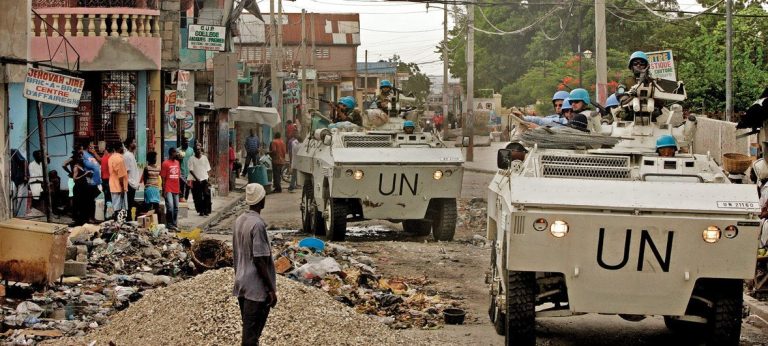by Peter Koenig, Global Research:

In his recent article “The Destabilization of Haiti: Anatomy of a Military Coup d’Etat“, Professor Michel Chossudovsky memorizes 29 February 2024 as the 20th anniversary of the coup d’État against Haiti’s elected president Jean-Bertrand Aristide.
He also describes the military motives for controlling Haiti, namely to destabilize the country and to plunge it into constant chaos. This is precisely what has happened. Haiti is in a constant state of near absolute poverty – by far the poorest country in all Latin America according to official UN / World Bank indices.
Is there a reason?
As we will see, Haiti is also one of the world’s richest countries, per capita, judged by available natural resources, oil and gas. Discovered before the 2010 earthquake and confirmed by the tremendous 7.0 Richter seism.
TRUTH LIVES on at https://sgtreport.tv/
Haiti’s Potential Hydrocarbon Deposits
The Economic Commission for Latin America and the Caribbean (ECLAC), issued in May 1980 a report under the Caribbean Development and Cooperation Committee (CDCC), describing the likelihood of large oil deposits in the Caribbean, including off-shore of Port-au-Prince, Haiti, see this. Haiti is also said to have trillions of dollars-worth of off-shore natural gas, see this.
These discoveries were likely made in the 1970s and 1980s, perhaps earlier, by US satellite imaging. US satellites have mapped the world for hydrocarbon resources already at least 50 years ago. Such information used to be available on internet – no longer.
Brief Haitian History and Background
François Duvalier, also known as Papa Doc, served as the president of Haiti from 1957 until his death in 1971. He was succeeded by his 19-year-old son, Jean-Claude Duvalier, nicknamed “Baby Doc”.
The Duvalier dynasty was an autocratic hereditary dictatorship, indiscriminately killing people who dared interfering with their government style. The dynasty empire lasted almost 29 years, from 1957 until 1986, spanning the rule of the father-and-son duo, François and Jean-Claude Duvalier. Both served the US’ political and economic interests.
The sociopolitical situation in Haiti deteriorated seriously under the regime of Baby Doc and his powerful wife. In 1986, President Reagon asked Jean-Claude to leave Haiti, so that the US could “help install” a more stable and serious government. In February 1986 Baby Doc fled to France in a US airforce jet.
The end of the Duvalier dynasty brought hope for “freedom” and democracy to the Haitian people. There was a succession of short-lived presidents until 1991, when Jean-Bertrand Aristide was first elected in February 1991. His presidency lasted 234 days, when a brief military government took over.
In the ten years following Mr. Aristide’s first election, the US-supported political turmoil in Haiti, with a succession of heads of state, during which Mr. Aristide was four times elected president.
His last presidency started in February 2001 and ended three years later when Mr. Aristide, Haiti’s first democratically elected President, was quietly deposed by a US-guided coup on 29 February 2004 and deported to South Africa, where he presumably still lives in exile. He was discouraged by the US State Department from returning to Haiti.
This coup was planned well in advance, by the US, France and Canada. The subsequent process of militarization (foreign troops) was undertaken on behalf of Washington Brazil under the helm of progressive “socialist” President, Luiz Inácio Lula da Silva – Lula for short — and George W. Bush, both then Presidents of their respective countries, Brazil and United States.
By now we know that Lula has nothing of progressive, and even less of “socialist” in him. He is and has been totally sold to the usurping west, to Wall Street and the IMF – and that already during his first two terms as President of Brazil, 2003-2011.
Both Lula and Bush are traitors of their countries but Lula, a make-believe socialist, has deeply betrayed his country during his first two terms, and now, since 1 January 2023, in his third term, but also the people of Haiti.
After associating with Wall Street and the IMF during his first two terms, Lula is again allying with the money brokers – the debt machines, as one may call them.
Remember during the French Revolution (1789-99), French black slaves in Haiti launched the Haitian Revolution (1791-1804), led by a former slave and black general of the French Army. After 12 years of struggle and conflict, Napoleon Bonaparte’s forces were defeated, and on 1 January 1804 Haiti declared her sovereign independence.
Haiti, thus, became the first independent nation of Latin America and the Caribbean, and the first country in the Americas to eliminate slavery. Haiti is the only state in history established by a successful slave revolt.
In the 1980s, with close to 200 years of independence (on January 1, 2024, Haiti celebrated 220 years of independence), a black, sovereign, autonomous island in the Caribbean was perceived as a “danger” for the United States’ “national security”. There already was a “Communist Cuba” to deal with just 90 miles (150 km) from the southern Florida border. A black independent, uncontrolled, Haiti was beyond limits for a still racist white US supremacy.
Plus, at that time, Haiti’s riches in petrol and gas were already known to Washington, though, most likely not to Haiti.
Thus, the US, French and Canada ganged up against Haiti’s government to control the island and her riches. Chaos was the modus operandi – and US-induced chaos and crime reign up to this day over Haiti.
The 2010 Earthquake
What is important to know is that there are no coincidences.
In the 1970s / 1980s and perhaps up to early 1990s, huge petrol resources were satellite-discovered deep under the sea floor off-shore from Port-au-Prince, Haiti. To get to these resources is expensive.
Unless they are brought up closer to the surface – for example by an earthquake, that cracks the tectonic plates, letting pressure bring the oil closer into shallower areas.



